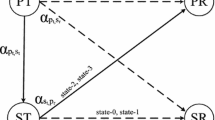Abstract
In the recent past, the Cognitive Radio Network (CRN) plays significant role in mobile technology for energy efficient wireless 5G communication. The Non Orthogonal Frequency Multiple (NOMA) communication technology is applied for energy efficient CRN wireless communication. The CRN is an important research area for 5G wireless communication that permit unlicensed Secondary Users (SU) to access the spectrum by achieving energy efficiency. The energy efficiency of SU can be optimized by providing Carrier Frequency Offset (CFO) synchronization and Peak Average Power Ratio (PAPR) minimization in a cooperative spectrum sensing of the CRN. The major issue in CRN is synchronization and error during the transmission and reception of input data. In this research, the synchronization and error correction techniques are proposed to improve the energy efficiency of CRN for improving 5G wireless communication. A novel algorithm is proposed for CFO synchronization and PAPR minimization. The quick calculation of synchronization variable plays an enormously significant part in the modulation and demodulation of CRN data. The novel algorithm is used to provide optimal solution in high computational complexity for various synchronization parameters such as CFO, timing error and PAPR by applying Offset Quadrature Amplitude Modulation (OQAM). The NOMA technology is incorporated for transmitting data by the SU with OQAM modulation. The experimental results prove that proposed methodology attains energy efficiency by improving synchronization and minimizing errors.






Similar content being viewed by others
References
Shah, H. A., & Koo, I. (2018). A novel physical layer security scheme in OFDM-based cognitive radio networks. IEEE Access, 6, 29486–29498. https://doi.org/10.1109/ACCESS.2018.2842826
Liu, C., & Xiao, L. (2019). Building $k$-protected routes in multi-hop cognitive radio networks. IEEE Transactions on Cognitive Communications and Networking, 5(4), 976–989. https://doi.org/10.1109/TCCN.2019.2932389
Davaslioglu, K., & Sagduyu, Y. E. (2018). Generative adversarial learning for spectrum sensing. In 2018 IEEE international conference on communications (ICC), Kansas City, MO, USA, pp. 1–6. https://doi.org/10.1109/ICC.2018.8422223.
He, Z., Zhou, L., Chen, Y., & Ling, X. (2018). Low-complexity PTS scheme for PAPR reduction in FBMC-OQAM systems. IEEE Communications Letters, 22(11), 2322–2325. https://doi.org/10.1109/LCOMM.2018.2871263
Sivakumar V., & Rekha, D. (2018). Node scheduling problem in underwater acoustic sensor network using genetic algorithm. Personal and Ubiquitous Computing, 22(5–6), 951–959. https://doi.org/10.1007/s00779-018-1136-3.
He, Z., Zhou, L., Chen, Y., & Ling, X. (2019). Nonlinear complex support vector regression for fading channel estimation in FBMC-OQAM system. IEEE Wireless Communications Letters, 8(3), 753–756. https://doi.org/10.1109/LWC.2018.2890647
Sivakumar, V., & Rekha, D. (2018). A QoS-aware energy-efficient memetic flower pollination routing protocol for underwater acoustic sensor network. Concurrency and Computation: Practice and Experience, 32(4). https://doi.org/10.1002/cpe.5166.
Van Nguyen, M.-S., Do, D.-T., & Voznak, M. (2019). Improving performance of far users in cognitive radio: Exploiting NOMA and wireless power transfer. Energies, 12(11), 2206. https://doi.org/10.3390/en12112206
Al-Rayif, M. I., Seleem, H. E., Ragheb, A. M., & Alshebeili, S. A. (2020). PAPR reduction in UFMC for 5G cellular systems. Electronics, 9(9), 1404. https://doi.org/10.3390/electronics9091404
Karmokar, A., Naeem, M., Anpalagan, A., & Jaseemuddin, M. (2014). Energy-efficient power allocation using probabilistic interference model for OFDM-based green cognitive radio networks. Energies, 7(4), 2535–2557. https://doi.org/10.3390/en7042535
Lin, S.-Y., Du, Y., Ko, P.-C., Wu, T.-J., Ho, P.-T., Sivaakumar, V., et al. (2020). Fog computing based hybrid deep learning framework in effective inspection system for smart manufacturing. Computer Communications, 160, 636–642. https://doi.org/10.1016/j.comcom.2020.05.044.
Baig, I., Farooq, U., Ul Hasan, N., Zghaibeh, M., & Jeoti, V. (2020). A multi-carrier waveform design for 5G and beyond communication systems. Mathematics, 8(9), 1466. https://doi.org/10.3390/math8091466
Abdel-Atty, H. M., Raslan, W. A., & Khalil, A. T. (2020). Evaluation and analysis of FBMC/OQAM systems based on pulse shaping filters. IEEE Access, 8, 55750–55772. https://doi.org/10.1109/ACCESS.2020.2981744
Usman, M., Khan, M., Vu-Van, H., & Insoo, K. (2015). Energy-efficient channel handoff for sensor network-assisted cognitive radio network. Sensors, 15(8), 18012–18039. https://doi.org/10.3390/s150818012
Fang, Y., Li, L., Li, Y., Peng, H., & Yang, Y. (2020). Low energy consumption compressed spectrum sensing based on channel energy reconstruction in cognitive radio network. Sensors, 20(5), 1264. https://doi.org/10.3390/s20051264
Zhang, P., Ge, W., Zhang, Y., Gao, M., & Zhang, G. (2020). Energy efficiency and user capacity optimization of cognitive MIMO systems via the SCMA-based nonorthogonal time slot allocation. Symmetry, 12(7), 1136. https://doi.org/10.3390/sym12071136
Ngo, H. A., Maunder, R. G., & Hanzo, L. (2015). Fully parallel turbo equalization for wireless communications. IEEE Access, 3, 2652–2664. https://doi.org/10.1109/ACCESS.2015.2503266
Liu, W., Rupp, M., Schwarz, S., & Jiang, T. (2021). Block-wise preamble design in OQAM/FBMC systems with interference cancellation. IEEE Communications Letters, 25(3), 1015–1018. https://doi.org/10.1109/LCOMM.2020.3040331
Xia, Y., & Ji, J. (2018). Low-complexity blind selected mapping scheme for peak-to-average power ratio reduction in orthogonal frequency-division multiplexing systems. Information, 9(9), 220. https://doi.org/10.3390/info9090220
AlHarthi, N., Zhang, Z., Kim, D., & Choi, S. (2021). Peak-to-average power ratio reduction method based on partial transmit sequence and discrete Fourier transform spreading. Electronics, 10(6), 642. https://doi.org/10.3390/electronics10060642
Kachroo, A., Popuri, A., Ibrahim, M., Imran, A., & Ekin, S. (2020). Interference spreading through random subcarrier allocation technique and its error rate performance in cognitive radio networks. Sensors, 20(19), 5700. https://doi.org/10.3390/s20195700
Bhattacharya, A. (2014). Energy-efficient multimedia communication for cognitive radio networks. Springer.
Mavromoustakis, C. X., Bourdena, A., Mastorakis, G., & Pallis, E. (2015). Using incoming traffic for energy-efficient routing in cognitive radio networks. Journal of Information Technology Research, 8(1), 1–24. https://doi.org/10.4018/JITR.2015010102
Author information
Authors and Affiliations
Corresponding author
Ethics declarations
Conflict of interest
The authors have no affiliation with any organization with a direct or indirect financial interest in the subject matter discussed in the manuscript.
Additional information
Publisher's Note
Springer Nature remains neutral with regard to jurisdictional claims in published maps and institutional affiliations.
Rights and permissions
About this article
Cite this article
Balachander, T., Krishnan, M.B.M. Carrier Frequency Offset (CFO) Synchronization and Peak Average Power Ratio (PAPR) Minimization for Energy Efficient Cognitive Radio Network (CRN) for 5G Wireless Communication. Wireless Pers Commun 127, 1847–1867 (2022). https://doi.org/10.1007/s11277-021-08726-3
Accepted:
Published:
Issue Date:
DOI: https://doi.org/10.1007/s11277-021-08726-3




